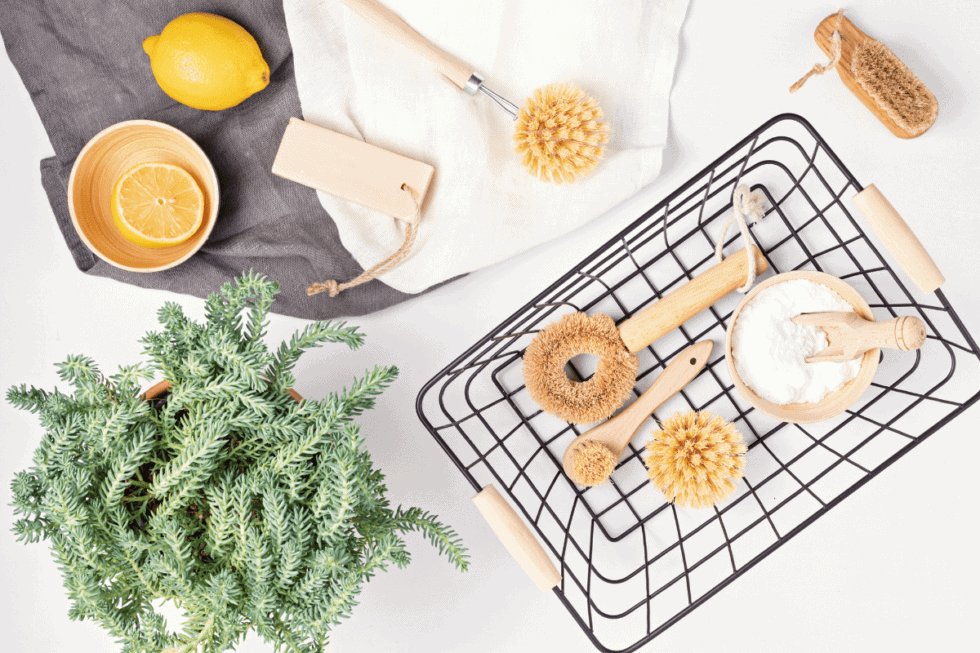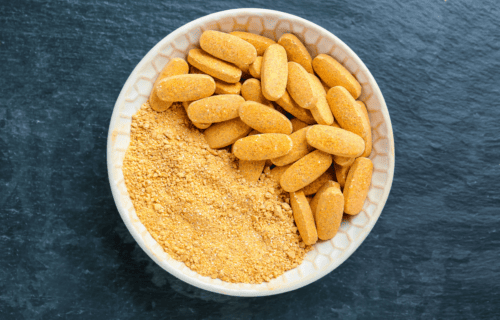
Safe Chemical-Free Cleaning Products for Mast Cell Activation Syndrome, Histamine Intolerance, and Chemical Sensitivity
If you have Mast Cell Activation Syndrome or Histamine Intolerance, you likely notice reactions to fragrances and chemicals.
Do you have to hold your breath when you go down the laundry detergent aisle at the grocery?
Do some cleaning products make you nauseous?
If someone is wearing anything fragranced, do you start to get a headache?
Does the smell of someone’s scented laundry detergent affect you?
Some of us with Mast Cell Activation Syndrome and Histamine Intolerance have immediate reactions to chemicals and fragrances. There are many people with mast cell and histamine issues who have trouble leaving their house because of this.
The majority of people with Mast Cell Activation Syndrome also have Chemical Sensitivity. This can affect people with Histamine Intolerance as well.
Others don’t notice anything immediately when exposed to fragrances and chemicals. But those fragrances and chemicals can set off a slower mast cell cascade with symptoms developing hours later. If you are a slower responder, then it can be really hard to track down your triggers.
This is why it is really important to avoid chemicals and fragrances if you have Mast Cell Activation Syndrome and Histamine Intolerance.
I started researching this article because my husband and I had a cleaning dilemma. Raw chicken dropped on the counter, and we needed a way to sanitize the counter.
I don’t like toxic bleach or other common disinfectant sprays, so I only use non toxic cleaning products in the house.
I wanted to use this Thyme Oil based disinfectant spray by Seventh Generation on the counters. But the smell of the thyme oil gives my husband a headache. And we both think vinegar stinks too much. What to do?
Let’s talk about why I avoid those toxic cleaners in the house first.
Then I’m going to share with you what we landed on for cleaning products that work great for both of us. And I’ll share some additional cleaning product resources with you too!
Cleaning Products and Other Chemicals Can Cause Symptoms
There are many different types of symptoms that can develop if you are sensitive to cleaning products and other chemicals.
They include:
- Breathing difficulties
- Headaches and migraines
- Nausea
- Fatigue
- Brain fog or trouble concentrating
- Sore throat and coughing
- Dizziness
- Runny nose or sinus issues
- Digestive symptoms
- Light and sound sensitivity
- Trouble sleeping
- Pain in muscles and joints
Do these sound similar to symptoms of Mast Cell Activation Syndrome (MCAS) and Histamine Intolerance? This is because chemicals can cause significant histamine release and mast cell activation.
Why Are Normal Cleaning Products an Issue with Mast Cell Activation Syndrome and Histamine Intolerance?
Sensitivity to fragrances and chemicals is a complex topic. There are a few different systems in the body that can be affected. Let’s take a look at those.
Immune Reactions
Mast cell reactions can occur when the mast cells register fragrances or chemicals as allergens. The mast cells will release inflammatory molecules.
If your mast cells are over-reactive from Mast Cell Activation Syndrome, this can set up an inflammatory cascade that persists for hours or days. Protocols that calm the mast cells can help with this.
Detoxification
Fragrances and chemicals have to be detoxed within the body. Issues with the CYP450 enzymes involved in detoxification can slow down the detox process of these chemicals.
This causes toxic levels of chemicals and fragrances to build in the body. High levels of circulating toxins will continue to stimulate the mast cells.
Supporting detoxification makes a big difference if detoxification is a factor.
Related Post: Why Lymph Drainage Is Important with MCAS
Limbic System
The limbic system is a part of the brain that controls emotions and basic instincts. It senses danger and responds with a flood of emotions like anxiety, fear, or anger.
When the limbic system is functioning properly, it keeps us safe from danger. But for many people with chronic illness, the limbic system gets dysregulated. This means it will go haywire and over-respond at the slightest smell of chemicals or fragrances.
Sounds like our mast cells, doesn’t it?
Does this mean chemical sensitivities are just in your head? Or that you are making it up? Absolutely not!
There is a field of medicine called psychoneuroendicrinoimmunolgy. This long word describes the intricate connections of the mind, nervous system, endocrine system, and immune system.
Most people with Mast Cell Activation Syndrome or Histamine Intolerance have some nervous system dysregulation. Resonant breathing, meditation, Qigong, and similar calming practices can help the limbic system heal.
Interested in creating a personalized nervous system support practice to help heal and calm mast cells? You might find my Nervous System Reboot helpful. I walk you through the steps of evaluating your nervous system and finding support tools that are a good fit for you.
Types of Chemicals That Are a Problem with MCAS
Many cleaning products contain toxic ingredients. And there is no federal regulation in the United States of toxic ingredients in household products. This means many of those products have unsafe and even cancer-causing ingredients. Here are some of the top offenders.
Fragrances
This is one of the most common allergens.
Fragrances include many known hormone disrupting and cancer-causing ingredients. Fragrance is often in cleaning products, laundry products, perfumes, colognes, soaps, lotions, and scented candles.
Anything with fragrance is toxic. Products using essential oils are a much better choice if you tolerate them. Or stick with unscented products.
Triclosan
This is an antibacterial product in many soaps.
The problem is it also kills all the healthy bacteria on your skin too. This can promote drug-resistant bacteria, like MRSA.
There is no evidence Triclosan prevents illness. And there are suspicions that is disrupts hormones and is carcinogenic.
Ammonia
This is in many glass cleaners and polishing compounds. It is a big contributor to asthma and bronchitis. It becomes highly poisonous, possibly deadly, if it is used around bleach.
Chlorine
This is in bleach products, many toilet bowel cleaners, and tub/sink powders. The fumes can cause breathing issues and skin problems. It can also disrupt the thyroid.
Other Ingredients
Other ingredients to watch out for are:
- 2-Bromo-2-Nitropropane-1,3-Diol (releases formaldehyde)
- Alkyl Dimethyl Benzyl Ammonium Chloride
- Alkyl Dimethyl Ethylbenzyl Ammonium Chloride
- Didecyldimethylammonium Chloride
- Diethanolamine
- Dioctyl Dimethyl Ammonium Chloride
- Distearyldimonium Chloride
- DMDM Hydantoin (releases formaldehyde)
- Ethanolamine
- Formaldehyde
- Glutaral
- Monoethanolamine Citrate
- Quaternium-15
- Quaternium-24
- Sodium Hypochlorite (Bleach)
- Sulfuric Acid
- Triethanolamine
Safely dispose of any cleaning products with these ingredients. It isn’t worth your health to keep using them!
Let’s look at some safer options, next.
Safe Cleaning Options
Now that we’ve covered which products to avoid, let’s talk about the ones that are safe!
Remember at the beginning of the article I talked about our issue with the raw chicken and how to sanitize the counters?
I was really excited to learn about Norwex from a colleague of mine, Mindy Nagel over at College Hill Physical Therapy and Pilates. I was telling her about our disinfecting dilemma and how there isn’t a spray we can use. She told me about Norwex products – have you heard of this?
I listed some great non toxic cleaners for you below.
Norwex Cloths
Norwex is a company that makes ultra-microfiber cloths with silver threads woven in. They claim their cloths are antibacterial and antiviral. They even say the cloths can remove up to 99% of bacteria on surfaces if used according to their directions.
Now, I’m naturally a skeptic. I research almost everything before I try it.
I wasn’t sure if this was hype or for real. But I really needed a solution though for the kitchen. So I started researching independent evaluations of Norwex online.
Here are independent evaluations that showed that Norwex did reduce bacteria on surfaces. This lab showed the Norwex cloths remove more bacteria than a paper towel and cleaning spray:
Here are some other independent tests of Norwex cloths:
After watching these, I was impressed and decided to try Norwex.
How does it work?
There is a video here with more information about how Norwex works for bacteria.
You can use these products for sanitizing counters. They can also be used for dusting, windows, polishing, floors, etc. Most people use different color cloths for the bathroom, kitchen, dusting, and windows to keep them separate.
If using the cloths for antibacterial purposes, you do want to wash them between uses. Be sure to follow washing instructions.
I’m using the Envirocloth & Window Cloth Bundle and the Mop System right now. I’m really happy with how well they are cleaning. And I feel great that I’m not causing any mast cell or histamine reactions for me or my husband.
I’m going to check out a number of the other products soon!
Upsides to Norwex are:
- 2 year warranty
- 60-day money back guarantee
- Can save significant money on cleaning products
- Reduces environmental waste
How to get Norwex Cleaning Products
There are a number of Norwex products available on Amazon.
You can get these on Amazon:
- Norwex Enviro Cloth – my favorite Norwex product. Wipe up counter top spills and remove bacteria without using disinfectant sprays.
- Norwex Window Cloth – just wet the cloth and use to clean mirrors and windows. Polish windows with a clean microfiber. No chemicals needed.
- Norwex Counter Cloths – use instead of paper towels and keep bacteria down
- Norwex Dusting Mitt – easily captures dust and more effective than toxic Pledge
- Norwex Enviro Sponges – for scrubbing kitchens and bathrooms. Baclock prevents bacterial growth in the sponge.
- Norwex Mop System – dry mop works as well as Swiffer but without the waste. Wet mop helps reduce bacteria on floors.
- Norwex Microfiber Travel Pack – smaller versions of antibacterial Enviro cloth
- Norwex Chenille Hand Towels – dries hands quickly and Baclock keeps the towel from growing bacteria. I really like this product, too.
Other Cleaning Product Options
Here are some other great cleaning products that are safer for people with Mast Cell Activation Syndrome and Histamine Intolerance than traditional cleaning products.
Fragrance Free Non Toxic Cleaners and Dishwashing Detergent
These are some of my favorites for around the house:
- Seventh Generation Fragrance Free Dishwasher Detergent Packs – enzymatic based that actually cleans the dishes; I use white vinegar diluted 50% with water in a glass container on top rack instead of glass rinse aid
- Seventh Generation Glass and Surface Cleaner
- Baking Soda – for cleaning sinks and tubs; mix with a little white vinegar for cleaning chrome
- Seventh Generation Fabric Softener Sheets, Free & Clear
- Norwex Cleaning Paste – non-toxic for polishing chrome, porcelain, and tile; environmentally friendly
- Norwex Laundry Detergent – non-toxic, enzymatic cleaner that is also good for the environment
Non Toxic Cleaners (with natural essential oils)
These are some of my favorites:
- Seventh Generation Disinfecting Multi-Surface Cleaner – I use their spray to disinfect the kitchen. It does have a strong Thyme oil smell. I take the Seventh Generation Disinfectant Wipes when I fly to wipe down my area on plane. I also take the spray to hotels to disinfect the room.
- Seventh Generation Toilet Bowel Cleaner
Chemical Sensitivity CAN Get Better
I have had severe chemical sensitivity. But fortunately it is much better now!
A few years ago, I had a severe asthma attack from walking into a hotel that had just shampooed the carpets.
I’ve had migraines from someone wearing cologne. One time I almost fainted while driving my dog home from the groomer when she forgot and applied perfume to my dog. A lung full of gasoline fumes caused my legs to give out one day.
I’ve had to work on calming my mast cells, supporting detoxification, and healing my limbic system. This made such a huge difference.
I still hold my breath in the laundry aisle at the grocery. But if I get a whiff of scented products, I don’t feel like I’m going to faint.
I walked into a store with a scented candle burning. I had to wait to pay and couldn’t get away very quickly. I felt a headache coming on. But I used resonant breathing and stayed calm.
Even though my Chemical Sensitivity has improved a lot, I still make sure to use safe cleaning products. And I only allow safe products to be used in my house if someone helps me with cleaning. This is because I want to keep my health gains.
You really need to consider all the possible underlying triggers if you have Mast Cell Activation Syndrome or Histamine Intolerance.
It is fairly easy to use safe cleaning and household products. So, don’t risk your health!
What are some of your favorite non toxic cleaners for a healthier home?
Ideas For a More Mast Cell Friendly Home
- Safe Skincare
- AquaTru Water Filter Review
- My Air Doctor Air Purifier Review
- The Air You Breathe Could Be Triggering Your Mast Cell Activation Syndrome
References:
D’Attis S, Massari S, Mazzei F, Maio D, Vergallo I, Mauro S, Minelli M, Bozzetti M, P: Assessment of CYP2C9, CYP2C19, and CYP2D6 Polymorphisms in Allergic Patients with Chemical Sensitivity. Int Arch Allergy Immunol 2019. doi: 10.1159/000497322.
Environmental Working Group’s Guide to Healthy Cleaning. Cleaning Supplied and Your Health. Accessed May 5, 2019. https://www.ewg.org/guides/cleaners/content
/cleaners_and_health.
Meggs, William J. The Role of Neurogenic Inflammation in Chemical Sensitivity (2017) EcopsychologyVol. 9, No. 2 Published Online:1 Jun 2017 https://doi.org/10.1089/eco.2016.0045
Seema Patel. Fragrance compounds: The wolves in sheep’s clothings, Medical Hypotheses, Volume 102, 2017, Pages 106-111, ISSN 0306-9877, https://doi.org/10.1016/j.mehy.2017.03.025.
Some links in this website are affiliate links, which means Mast Cell 360 may make a very small commission if you purchase through the link. It never costs you any more to purchase through the links, and we try to find the best deals we can. We only recommend products that we love and use personally or use in the Mast Cell 360 practice. Any commissions help support the newsletter, website, and ongoing research so Mast Cell 360 can continue to offer you free tips, recipes, and info. Thank you for your support!




I do want to offer fragrance and chemical free pre-cleaning options for guests with MCAS and similar sensitivities. Your article has given me the info I needed. Thanks!
Hi Alison! Glad to hear that the blog was helpful!
This is SO helpful! I have a question. Do you know if mast cells can accumulate on surfaces like sheets? Or are they 100% under the skin. I’m a chronic hive sufferer and was wondering if I should change my sheets more often. I have been leaving them a little longer to avoid detergent but then it didn’t seem to be helping so I thought “am I just making it worse?”
Hi Tory, I’m so sorry to hear you’re dealing with chronic hives. Mast Cells are in every part of the body except your retina. You may look at some other areas in your home that may be triggering the hives. If they are mostly occurring at night when in your bed, you may want to explore whether there is a trigger like chemicals or mold in your mattress as well. You might find this blog of interest: https://mastcell360.com/non-toxic-mattress/. Since we are unfamiliar with your case we cannot say what is causing your hives. Please note our resources are for informational and educational purposes only.
Have you looked into VitalOxide brand? I had someone recommend it to me from an online MCAS group. I didn’t compare ingredients but supposed to be hospital grade and doesn’t have a smell to me.
Hi Tiffany, VitalOxide is not a brand that we have experience with so are unable to comment on it at this time.